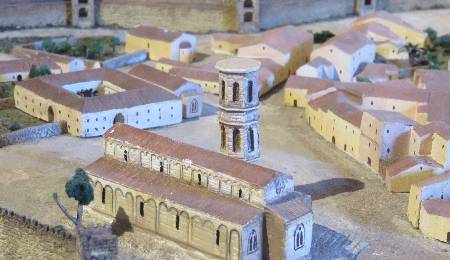 Antiquarium Arborense - Museo archeologico Giuseppe Pau Oristano
Antiquarium Arborense - Museo archeologico Giuseppe Pau Oristano
Skip over navigation bar and go to contents

Piazza Corrias, 09170 Oristano -
Tel: 0783 791262 -
info@antiquariumarborense.it
Contents
Miniature models: Tharros in the 4th century and Oristano capital of the Giudicato d'Arborea
MINIATURE MODEL OF THARROS IN THE 4th CENTURY A.D.
This miniature model represents the city of Tharros during its heyday, when Constantine was emperor.
Tharros was a Phoenician city: some fragments of geometrical Greek ceramics and Phoenician crockery, found in Muru Mannu hill, date back to the VIII century B.C.
Its urban development goes back to the domination of Carthage, which established Tharros as “new city”, a real Carthage in Sardinia.
After the first Punic war (241 B.C.), in 238-37 B.C. Tharros passed under Roman dominion, and the city kept its importance as trade centre.
MINIATURE MODEL OF ORISTANO CAPITAL OF THE “GIUDICATO D’ARBOREA” (11th century-1410)
After the abandonment of Tharros (1070), the city of Oristano became the capital of the Kingdom of Arborea (11th century-1410). The people from Tharros, forced out by raids by Saracen pirates, decided to move to a safer place, so they arrived in Oristano.
Soon the new capital had a defensive system that was developed at the end of 1200 by king Mariano II de Bas Serra.
This is the reconstruction of the city of Oristano at the end of the 14th century: there are three towers, the main entrances to the city, and 28 smaller towers.
Northward the tower of Mariano II, also called Porta Manna (the biggest entrance) or Porta Pontis (facing a Roman bridge); southward the tower of San Filippo, identical with the first, connected to the palace of the king; eastward the tower of Portixedda, a smaller tower with an original square plan, modified during the Spanish occupation to withstand the cannonballs.
The Tirso river feeds the moat that runs along the wall, making still more unbreachable the city that here you see reconstructed, with the most important religious buildings of that period: the Romanesque Cathedral of Santa Maria Assunta, the convent and the church of San Francesco, the hospital, the church of San Mauro, the church dedicated to San Saturnino and, in the end, the church and convent of cloistered nuns of Santa Chiara.
© Antiquarium Arborense - Museo archeologico Giuseppe Pau Oristano
Piazza Corrias, 09170 Oristano | Tel: 0783 791262 | info@antiquariumarborense.it ConsulMedia 2012
Piazza Corrias, 09170 Oristano | Tel: 0783 791262 | info@antiquariumarborense.it ConsulMedia 2012









